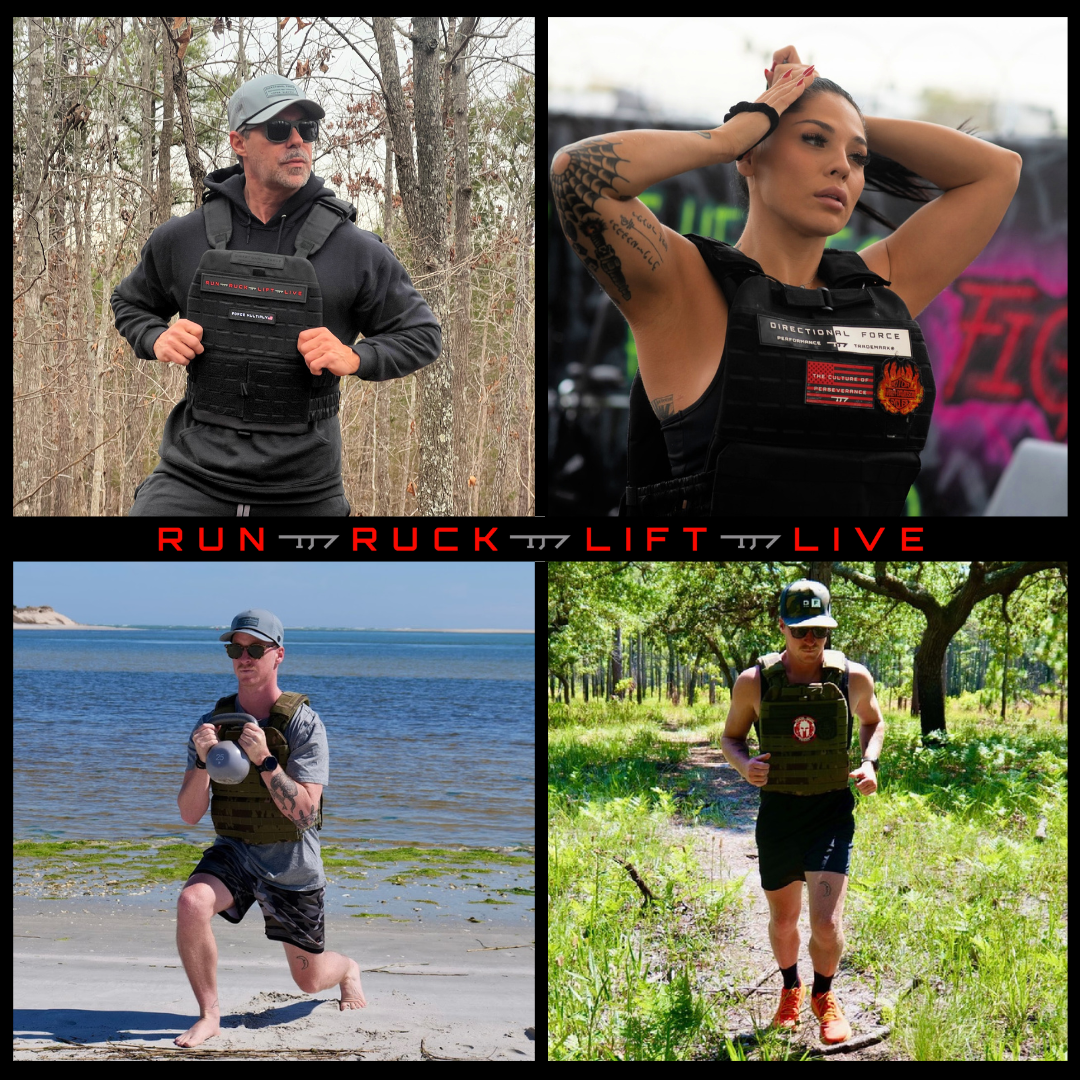In the quest for functional fitness, two tools have risen to prominence: the weight vest and the ruck pack. Both add resistance to workouts, turning simple walks or bodyweight exercises into strength-building, calorie-torching sessions. But which is the best overall fitness tool? This article dives into the benefits, drawbacks, and practical applications of each, drawing on expert insights, research, and real-world use to help you decide.
What Are They?
-
Weighted Vest: A snug-fitting garment that distributes weight evenly across your torso, typically with adjustable weights (10-50). It’s designed for versatility, enhancing bodyweight exercises, walking, rucking, or running.
-
Ruck Pack: A weighted backpack, often used in military-style "rucking," where you carry heavy loads (10-60 lbs or more) over distances. It’s built for durability and utility, with compartments for gear like water or snacks.
Both tools elevate workouts by adding resistance, but their design and application cater to different fitness goals and lifestyles. Let’s break it down.

Benefits of Weighted Vests
Weighted vests shine for their balanced weight distribution and versatility. Here’s why they’re a favorite:
-
Even Load Distribution: The weight sits close to your body’s center of gravity, reducing strain on the lower back and preserving natural gait. This makes vests ideal for dynamic movements like push-ups, pull-ups, squats, or sprints.
-
Versatility: Vests enhance a wide range of exercises, from bodyweight circuits to running. Adjustable weights (often in small increments) allow you to scale intensity gradually as you gain strength.
-
Bone Health: The added load stimulates bone-forming cells, potentially improving bone density, especially in the spine and hips—crucial for aging populations or women in midlife.
-
Improved Posture: A snug vest encourages an upright stance, engaging core and upper body muscles to maintain stability.
-
Low-Impact Intensity: Vests boost calorie burn (30-50% more than regular walking / Rucking, and cardiovascular endurance without the joint stress of running.
-
Ease of Use: Vests are “idiot-proof”—strap it on, and the weight is distributed correctly without fuss.
- Overall the most functional fitness tool: You're able to go on long rucks with it as well as adding intensity to your bodyweight workouts. No need for a gym. You can also opt to add a ruck pack on top of your weight vest for long rucks, etc. Add a hydro-pack to your weight vest and it edges out the ruck pack in overall hybrid use.
-
Zone 2 Cardio: Rucking with heavier loads (20-50 lbs) elevates heart rate into the fat-burning Zone 2, ideal for long-duration, low-impact cardio.
-
Mental Grit: If you're willing to put in the work with your weight vest you will improve your health, help you lose weight, and build mental toughness.
Benefits of Ruck Packs
Ruck packs, rooted in military training, are built for endurance and real-world functionality. Here’s what makes them stand out:
-
Functional Strength: Rucking mimics real-life tasks like carrying gear, engaging shoulders, back, core, and legs. It’s ideal for building stamina for hiking, military training, or daily chores.
-
Utility: Unlike vests, ruck packs double as gear carriers because it's really just a backpack with weight. You can pack water, snacks, or even a laptop, making them practical for commuting or travel.
-
Posture Correction: The weight on your back forces shoulders back, countering the hunched posture common in desk-bound lifestyles.
-
Zone 2 Cardio: Rucking with heavier loads (20-50 lbs) elevates heart rate into the fat-burning Zone 2, ideal for long-duration, low-impact cardio.
-
Accessibility: Most people already own a backpack. Add books or weights, and you’re rucking without a big investment. High-quality ruck packs offer padded straps and durable construction.
-
Mental Grit: Long rucks build mental toughness, especially in group settings, fostering camaraderie and resilience.
Drawbacks and Considerations
No tool is perfect. Here’s where each falls short:
-
Weighted Vest Drawbacks:
-
Limited Utility: Vests are workout-specific, lacking storage for gear or everyday use. Ruck packs are backpacks with more storage, etc.
-
Weight Limits: Vests typically max out at 10-50 lbs, less than some ruck packs.
-
-
Ruck Pack Drawbacks:
-
Uneven Weight: Weight concentrates on the upper back and shoulders, potentially causing strain if not packed correctly or if straps aren’t adjusted properly.
-
Learning Curve: Proper packing (weight high and close to the back) and strap adjustment are crucial to avoid swaying or injury.
-
Lower Back Strain: The posterior load shifts your center of gravity, requiring a forward lean that can stress the lower back over time.
-
Limited Versatility: Ruck packs are less suited for dynamic exercises like burpees or pull-ups due to bulk and restricted mobility.
-
Sweat and Maintenance: Packs can absorb sweat, requiring frequent cleaning, which is more tedious than wiping down a vest.
-
Performance Comparison
-
Strength and Muscle Building: Weight vests excel for bodyweight exercises (e.g., push-ups, squats) due to even weight distribution and minimal interference with movement.
-
Endurance: Both excel here. Ruck packs are designed for rucking / hiking or military-style marches. You can get in long rucks in your vest as well and add a backpack to carry additional gear you may need on your ruck.
-
Calorie Burn: Both burn 30-50% more calories than regular walking.
-
Bone Density: Vests directly load the spine and hips, making them slightly more effective for bone health.
-
Mobility: Vests allow greater freedom of movement for dynamic workouts, while ruck packs are bulkier but more comfortable for long walks with proper fit.
Who Should Choose What?
-
Choose a Weighted Vest If:
-
You want a versatile tool for bodyweight exercises, running, rucks, or short walks. Upside potential is that it's like having a home gym.
-
Bone health and posture improvement are priorities.
-
You prefer a low-maintenance, snug-fitting option that’s easy to use.
-
You’re a beginner or prioritize dynamic, gym-style workouts.
- No Need for a Gym
- Unlimited training capabilities
-
-
Choose a Ruck Pack If:
-
You enjoy outdoor activities like hiking or want a tool that doubles as a gear carrier.
- You’re training for endurance, military events, or functional strength.
The Verdict
There’s no one-size-fits-all answer. Weight vests are the best overall fitness tool if your goals center on versatility, bone health, and dynamic workouts. Their even weight distribution and ease of use make them ideal for beginners and gym enthusiasts. Ruck packs take the crown for endurance, functional strength, and real-world utility, especially for outdoor lovers or those training for specific challenges like ruck events.
For maximum benefits, consider alternating between both. A vest can spice up bodyweight circuits or short walks, while a ruck pack powers long hikes or daily commutes. As fitness expert Morgan Fielder notes, “Try several approaches to find what suits you perfectly.” Start light (10% of bodyweight, as suggested by @AJA_Cortes), prioritize proper fit, and consult a healthcare professional if you have pre-existing conditions.
Get Started
-
Pro Tip: Begin with 10-20 lbs, walk 30-60 minutes in Zone 2 (60-70% max heart rate), and progress gradually to avoid injury.
- Pick a quality vest or ruck pack with quality padding and durable construction
Whether you strap on a vest or sling on a ruck, both tools transform simple movements into powerful weight loss and fitness gains. Choose based on your goals, lifestyle, and budget, and get moving!
Disclaimer: Always consult a healthcare provider before starting any workout program or physical activity to make sure that you're healthy enough.
The content contained in this article is for information purposes only, and is not meant to be a substitute or replacement for professional advice and medical consultation. It is just shared as information only, and with the understanding that Directional Force, LLC, (Directional Force) is not engaged in the provision or rendering of medical advice or services whatsoever. You unilaterally understand and agree that Directional Force shall not be liable for any claim, loss, or damage arising out of the use of, or reliance upon any content or information in this article or any article provided by Directional Force. Please seek professional medical advice prior to engaging in, or undertaking any of the content, exercises, advice, and workouts provided by Directional Force.


